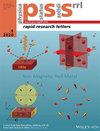Linear and Nonlinear Optical Properties of GeSe1‐xTex Chalcogenide Materials Promising for On‐Chip Low and Ultra‐low Loss Reconfigurable Photonics and Nonlinear Devices
IF 2
4区 物理与天体物理
Q3 MATERIALS SCIENCE, MULTIDISCIPLINARY
引用次数: 0
Abstract
The highly promising linear and non‐linear optical properties of innovative thin films of GeSeGeSe1-xTex 卤化物材料的线性和非线性光学特性有望用于片上低损耗和超低损耗可重构光子学和非线性设备
本文揭示了创新的 GeSe1-x Te x 卤化物薄膜在非晶沉积态和结晶后极具前景的线性和非线性光学特性。这些创新合金弥补了掺杂玻璃(GeSe)和相变材料(GeTe)两类材料之间的差距。它们独特的光学特性使其成为红外可重构和非线性光子应用的理想候选材料。在此背景下,我们展示了如何通过改变 GeSe1-x Te x 薄膜中 Te 的含量来定制其线性和非线性光学特性,从而优化它们,使其适用于广泛的创新应用。本文受版权保护。
本文章由计算机程序翻译,如有差异,请以英文原文为准。
求助全文
约1分钟内获得全文
求助全文
来源期刊

Physica Status Solidi-Rapid Research Letters
物理-材料科学:综合
CiteScore
5.20
自引率
3.60%
发文量
208
审稿时长
1.4 months
期刊介绍:
Physica status solidi (RRL) - Rapid Research Letters was designed to offer extremely fast publication times and is currently one of the fastest double peer-reviewed publication media in solid state and materials physics. Average times are 11 days from submission to first editorial decision, and 12 days from acceptance to online publication. It communicates important findings with a high degree of novelty and need for express publication, as well as other results of immediate interest to the solid-state physics and materials science community. Published Letters require approval by at least two independent reviewers.
The journal covers topics such as preparation, structure and simulation of advanced materials, theoretical and experimental investigations of the atomistic and electronic structure, optical, magnetic, superconducting, ferroelectric and other properties of solids, nanostructures and low-dimensional systems as well as device applications. Rapid Research Letters particularly invites papers from interdisciplinary and emerging new areas of research.
 求助内容:
求助内容: 应助结果提醒方式:
应助结果提醒方式:


